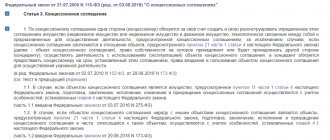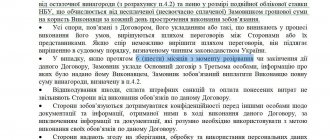An agreement of intent is necessary to determine the essence of future legal relations and establish certain conditions. Such a document usually states:
- what kind of deal will be concluded in the future;
- conditions that the parties must fulfill before concluding the main contract;
- How long will it take for the parties to conclude the main deal?
First of all, an agreement of intent is needed to pre-fix the terms of a future transaction, while retaining the opportunity to refuse to conclude it. For example, this is convenient if the seller is negotiating with several potential real estate buyers at once.
Also, a written letter of intent can serve as evidence that the parties actually negotiated the deal. In particular, it may be required when recovering damages if your partner suddenly and unjustifiably interrupted negotiations.
Finally, an agreement of intent can help out an entrepreneur if he has disagreements in the execution of an agreement that he concluded with a partner on its basis. Thus, when interpreting a contract, the court may also turn to the agreement of intent in order to establish the actual common will of the parties.
Example of use on "Secret"
“Polish 3D printer manufacturer Zortrax announced in early 2014 that it had signed a contract to supply 5,000 M200 3D printers to American giant Dell. After this, many world media wrote about the then small company, Polish additive technologies began to be considered high-quality, and investors began to massively finance the country’s startups, including Zortrax itself. Subsequently, it turned out that the deal was only an agreement of intent and did not reach completion, and all the success turned out to be a myth.”
(From the news of how 3D printer maker Zortrax's biggest deal turned out to be a scam.)
Compilation rules
A letter of intent to enter into an agreement is presented in law as ordinary correspondence. This does not require special preparation; the document is drawn up depending on the issue being discussed.
Taking into account the practice of use, essential conditions of a letter of intent to enter into an agreement are considered to be:
- name of the sender, details of the legal entity;
- terms of the proposal, designation of specific positions or opportunities for further discussion;
- deadlines for providing a response;
- signature of an authorized person.
It is recommended to draw up a letter of intent to enter into an agreement on company letterhead with the relevant details and contact information. If the document contains a mention of previously concluded agreements, provide the relevant details.
If a letter of intent contains detailed, clear terms of the transaction, the rights and obligations of the parties, and other characteristic provisions, such a document is considered an offer . It may be sent to one or more organizations depending on the nature of the proposal.
If there is no specific information about the addressee, and the letter contains detailed terms of the contract, the document is considered a public offer . This option is more often used in relation to individuals, for example, with an offer to conclude an employment contract or formalize a purchase and sale transaction.
Errors in use
Civil law does not provide for an “agreement of intent,” however, in accordance with Art. 429 of the Civil Code of the Russian Federation, the legislation offers a similar tool - a preliminary agreement. Don't confuse these two concepts. The main difference is that the agreement of intent does not entail legal consequences in the event of one of the participants refusing to conclude the main agreement in the future. The preliminary agreement provides that the parties undertake to conclude the main agreement in the future upon signing the preliminary agreement.
Memorandum of Intent
A memorandum of intent is a preliminary, non-legally binding document that precedes contracts. It is drawn up before an acquisition/merger, investment, and serves to consolidate the agreements reached during negotiations on future contacts.
In English-language literature, another term is more often used - letter of intent. LOI, or Letter of intent, unlike that accepted in the Russian-speaking environment, contains more general instructions. The author of such a document states that he plans to:
- purchase goods (a certain quantity) - indicating approximate conditions;
- sign contract;
- buy/sell shares;
- invest funds in the object;
- enter fully or partially into the management of the enterprise.
The purposes of such a document include identifying the terms of the agreement:
- quantity of products;
- quality and characteristics of purchased goods;
- delivery conditions;
- the price at which a party agrees to a transaction.
The purposes also include providing information about the buyer, including details, providing guarantees, notification of other intentions upon completion of the transaction or execution of a specific contract.
Cases of using a memorandum of intent
It is optimal to use the memorandum at the stage of evaluating proposals and selecting a prospective investor or seller/buyer. The parties can, after analyzing the proposals received, agreeing on the transaction criteria (terms, conditions, cost) and conducting due diligence, receive final proposals and select a specific investor or buyer.
After this, a memorandum of intent (LOI) is concluded, in other cases it is replaced by an agreement on lending conditions, the so-called term-sheet. The last stage, including the formation and signing of the memorandum, takes an average of 2–4 weeks.
This document allows you to:
- record the intentions of the parties;
- draw up specific parameters of the transaction (investment, acquisition/merger);
- give time and opportunity at the end of negotiations to study the agreements and make a final decision;
- formalize and transfer oral agreements into documentary form.
Features of documents
Several types of documents are in circulation at the same time: LOI (letter of intent), MOU (protocol of intent, memorandum of understanding), agreement of intent (clearer and containing a more accurate description of the subject of the agreement, in fact - a preliminary agreement).
A letter of intent records the intentions of the parties in the event of investing in a property, mergers and acquisitions of companies. An LOI never becomes legally binding; it only lists the terms and conditions of the transaction and its approximate terms. If one of the parties is a banking organization, such a letter is replaced with the Term Sheet. Important: The LOI is signed by both parties.
The second option is signed after Due Diligence, an almost mandatory stage of venture investment. The company's activities are comprehensively studied, and aspects of the activity are identified both on the basis of the provided business plan and from the sales memorandum. After this, a legal document is signed - a Memorandum of understanding, or MOU. The Memorandum of Understanding also specifies the terms of the agreement, the responsibilities of the parties, and the requirements. In fact, this is a reasonable documentary form of a “gentleman's agreement.” The memorandum outlines joint actions and determines their order and consistency.
No type of memorandum of intent (memorandum of intent, preliminary, letter) requires mandatory execution (does not include legally binding norms).
The main reasons for signing a memorandum of intent
There are several justifications for using the document, but there are two main ones.
- Fixation of specific agreements (price limits, unsuitable options, procedure for joint actions).
- Psychological aspect (fear of the parties to lose reputation if the conditions were changed / not met).
Legal side of the issue
You should not expect that an agreement/letter/contract/memorandum of intent will force the other party to sign an agreement or complete a transaction. The obligations are not specified in the document. In addition, the written document is not clearly described and supported by law. The Civil Code of the Russian Federation does not describe such a situation at all, other than indicating a preliminary agreement. The Civil Code of the Russian Federation contains only a description of such an agreement, according to which the parties undertake to perform a certain action (conclude a deal) in the future. In Art. 429 of the Civil Code of the Russian Federation indicates the possible future:
- transfer of property;
- performance of work / provision of services.
In this case, the terms of the transaction are taken from the preliminary agreement. If a party or both parties evade the transaction, it is recommended to apply the rules from clause 4 of Art. 445. However, an agreement or memorandum of intent does not equal a preliminary contract (Article 431, which states that such a document must be based on the unambiguous expression of the obligation to conclude an agreement after a memorandum or other preliminary document).
As a result, the only instrument described by the Civil Code of the Russian Federation is the so-called preliminary agreement, but it serves as a guarantee of the mandatory completion of a transaction, and therefore is not a direct analogue of a memorandum of intent.
Return to list
Answer
An agreement of intent can be recognized as a major transaction only if it meets two criteria at the time of its completion:
- quantitative – focus on the acquisition, alienation or possibility of alienation by the company, directly or indirectly, of property or results of intellectual activity, the price or book value of which is 25 percent or more of the book value of the company’s assets;
- high-quality - the transaction goes beyond ordinary business activities.
At the same time, consent for the company to carry out a major transaction requires the mandatory indication of its price.
Thus, if at the time of reaching an agreement of intent it is not possible to determine the value of the subsequent transaction (transactions), then this agreement cannot be recognized as a major transaction (there is no quantitative indicator). Accordingly, such an agreement does not require approval.
Letter of intent to enter into an agreement: sample
Sample letter here.
To the General Director of the Limited Liability Company "Transportnaya" (name of legal entity)
Kantimirov Ruslan Sergeevich (full name)
City of Stavropol, Zavodskaya street, house No. 34
Letter of agreement
I ask you to conclude an AGREEMENT for the carriage of goods (type of agreement).
- Customer (full legal name): Private Joint Stock Company "Kochubey Sugar Factory"
- Address: (Legal address, Postal address) Stavropol region, Kochubeevsky district, Kochubeevskoye village, Volnaya street 1v
For mail: 357000 Stavropol Territory, Kochubeevsky district, Kochubeevskoye village, Volnaya street 1v
- INN/KPP 2345679821
- Current account 26003456987001
- Name and address of the bank "Stavpropolprostroybank", city of Stavropol, Krasnoflotskaya street 88a
- Corr. account 31098776543212345690
- BIC 094567891
- Tel/fax, fax
- Full name of the director, position (in full), acting on the basis of Nikolai Ivanovich Kovalsky, Chairman of the Board, acting on the basis of the Charter
- Full name of the head accountant (in full) Semenikhina Maria Timofeevna
Head __________________/ Kovalsky Nikolay Ivanovich/
MP
Authorized person (full name, telephone): Nikolay Ivanovich Kovalsky, 8(6550)23 56 78
Drawing up an agreement
As part of this article, we provide our users with the opportunity to download a standard template of a letter of intent and familiarize themselves with a sample of how to fill it out.
In general, the letter of intent is drawn up according to standard rules for drawing up contracts and includes the following structural elements:
- date and place of conclusion of the agreement;
- names and details (or full name, address and passport details) of counterparties;
- expression of the mutual desire of the parties to enter into an agreement of intent;
- statement of intentions;
- approximate terms for concluding the main contract;
- the conditions under which the parties intend to conclude the main agreement;
- signatures of the parties.
An agreement is drawn up in the number of copies corresponding to the number of counterparties.
Is it possible to use a previously completed supply agreement as an example?
Despite the fact that each supply agreement in many cases contains an individual set of transaction terms, a standard goods supply agreement or just a sample of one can be a significant help in developing your document. In particular, studying different samples can help in choosing the optimal method of payment for the goods for the parties and, just as important, accurately formulate the agreed terms.
Thus, it is possible to include provisions in the contract:
- on the procedure for transferring ownership of goods;
- the consequences of the delivery of low-quality or incomplete goods and options for resolving these situations;
- delivery and shipment procedures;
- product packaging;
- procedure for resolving disputes.
Supply contract under the Civil Code of the Russian Federation
According to the Civil Code of the Russian Federation, a contract for the supply of goods is a document that allows you to formalize a transaction in writing, under the terms of which one entity (supplier-entrepreneur) is obliged to supply high-quality commercial products of a certain range within a specified time frame and at an agreed price, and the other (buyer) is obliged to accept the delivered products and pay no later than the agreed date.
The main regulatory document defining the legislative terms of the supply contract is the Civil Code of the Russian Federation. The agreement in question is devoted to § 3 of Chapter 30 of the Code, which contains:
- definition of contract;
- the procedure for resolving controversial issues when concluding such a transaction;
- provisions on the frequency of deliveries of a commercial product;
- the order of delivery of goods;
- clarification of delivery conditions;
- provisions on compensation for shortfalls in commercial products;
- rules for acceptance of goods by the buyer;
- explanations about the fate of goods not accepted by the buyer;
- rules for payment for goods;
- explanations of the consequences of delivery of low-quality or incomplete goods;
- issues of contract termination.
Also, the procedure for drawing up the said agreement is subject to the rules on transactions (Chapter 9 of the Civil Code of the Russian Federation) and the calculation of deadlines (Chapter 11 of the Civil Code of the Russian Federation), provisions on the contract (Section 3 of the Civil Code of the Russian Federation) and other norms of civil legislation.
If you are a buyer, get a free trial access to K+ and go to the Supply Deal Guide. If you are a supplier, go to the K+ system and use the Supplier Guide for free.
Results
Thus, the law does not provide for a single unified form of the supply agreement, as well as a sample of this document. However, developing a document for each specific transaction requires following the provisions of the law, which are described in the article. You can download a standard sample contract for the supply of goods on our website.
Sources:
- Resolution of the Plenum of the Supreme Arbitration Court of the Russian Federation dated October 22, 1997 N 18
- Civil Code of the Russian Federation
You can find more complete information on the topic in ConsultantPlus. Free trial access to the system for 2 days.
Civil Code of the Russian Federation on the essential terms of the supply contract
According to Art. 432 of the Civil Code of the Russian Federation, essential conditions are those provisions of a contractual document, without the approval of which the latter cannot be considered concluded. Common to all contracts in this case is the condition on the subject of the transaction. In addition, these provisions include conditions directly specified in the law, as well as those on which it is necessary to reach agreement at the request of one of the counterparties.
Regarding the supply contract, the main conditions are the following:
- Subject of the transaction. The contract document must indicate the name and quantity of commercial products (clause 3 of Article 455). At the same time, references only to generic characteristics of products should be avoided, since judicial practice on recognizing such contracts as not concluded is controversial. The quantity of a commercial product is determined either in units of measurement or in monetary terms. If units of measurement are used, they must be consistent with the nature of the goods, otherwise the condition may be considered inconsistent.
- Delivery time. The condition presupposes that the parties agree on the time of delivery of marketable products (Article 506 of the Civil Code of the Russian Federation). At the same time, the Supreme Arbitration Court of the Russian Federation allows, in the absence of a condition on the delivery time in the contract document, to determine it based on the provisions of Art. 314 of the Civil Code of the Russian Federation (clause 7 of the resolution of the Plenum of the Supreme Arbitration Court of the Russian Federation dated October 22, 1997 No. 18).
- Based on the definition of the supply contract given in Art. 506 of the Civil Code of the Russian Federation, the supplier-seller must be engaged in entrepreneurial activities, that is, only a legal entity or an individual entrepreneur can act as this party.






